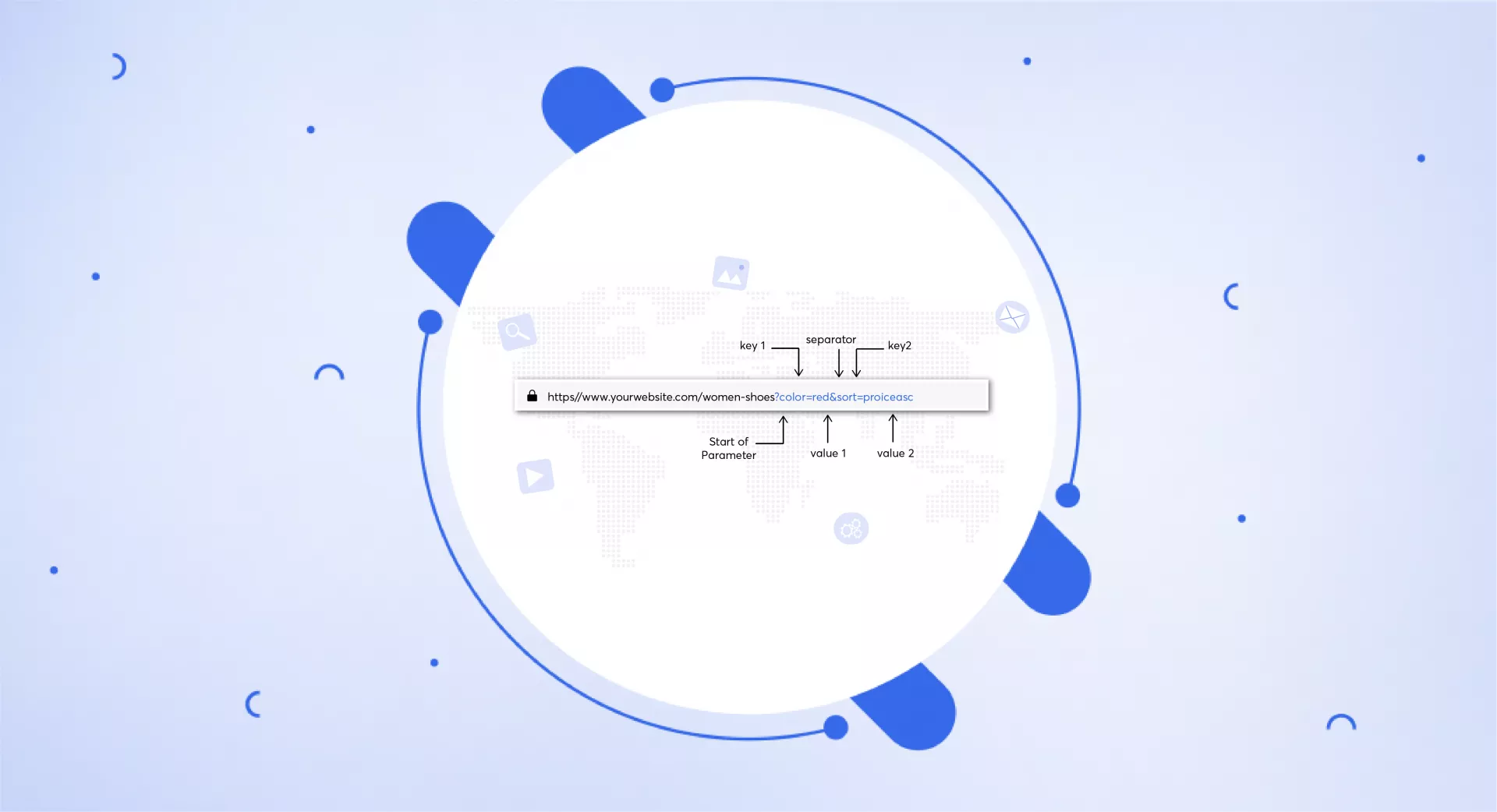What are URL Parameters?
URL parameters—also known as query strings or query parameters—are components added to the end of a URL to pass data. These are frequently used on e-commerce and content-heavy websites to help with product filtering, tracking, and sorting.
They serve two main purposes: enhancing user experience by allowing content filtering and navigation, and enabling website owners to monitor traffic sources for better marketing alignment.
The basics of URL parameters
URL parameters appear after a question mark (?) in a URL and are composed of key-value pairs. Multiple parameters can be added and separated using an ampersand (&). Each key and value pair is joined with an equals sign (=).
Example URLs with parameters:
https//www.yourwebsite.com/page?key1=value1&key2=value2
https//www.yourwebsite.com/women-shoes?color=red&sort=priceasc
Breakdown:
“?” indicates the start of the query string
“Key” represents the variable (e.g.,
color,sort)“Value” provides the value for that key (e.g.,
red,priceasc)“&” separates multiple key-value pairs
“=” assigns a value to a key
How do URL parameters work?
Google classifies URL parameters into two main types:
Active Parameters (Content-Modifying)
These parameters influence the page's displayed content. Common use cases include:
Filtering and sorting: Display refined product results
?color=red
?sort=highest_rated
Pagination: Divide content into multiple pages.
?page=2 or ?p=3
Language Translation: Switch between language versions.
?lang=de
?lang=en
Search Queries: Display results from internal site searches
It can be:
?q=shoes
?search=backpack
Passive Parameters (Tracking Only)
These parameters don’t alter page content but help in tracking and analytics.
Common examples:
Affiliate IDs: Identify referral sources
?id=partner123
Session IDs: Track user sessions (now outdated)
?sessionid=abc123
UTM Tags: Monitor ad campaign performance
?utm_source=newsletter&utm_medium=email
URL parameters and SEO
While URL parameters can be useful, they often pose SEO challenges if not managed correctly. Search engines may treat each unique parameterized URL as a separate page, leading to duplication, crawl inefficiency, and ranking difficulties.
Common SEO Issues
Duplicate Content
When parameters generate URLs that display similar or identical content, it leads to duplicate versions of a page. Google might index them separately, splitting ranking signals.
2. Crawl Budget Waste
Google has a limited crawl budget per site. Crawlers may spend excessive time navigating redundant parameterized URLs, causing important pages to be missed or delayed.
“Overly complex URLs, especially those containing multiple parameters, can cause problems for crawlers... Googlebot may consume much more bandwidth than necessary, or may be unable to completely index all the content on your site.” – Google
3. Diluted Page Authority
Inbound links to different parameterized versions can divide link equity across multiple URLs instead of consolidating it on a single authoritative page.
SEO Best Practices for Managing URL Parameters
To prevent SEO issues caused by URL parameters, follow these recommended practices:
Link to the Canonical (Static) Version
Internally link to the cleanest version of a URL without parameters. Avoid linking to filtered or sorted variants.
Example:
Preferred URL:
www.example.com/ladies-bags
Avoid Linking To:
www.example.com?q=ladies-bagswww.example.com/ladies-bags?color=bluewww.example.com/ladies-bags?type=totes
Use Canonical Tags
Add a canonical tag to parameterized URLs pointing to the static version. This tells search engines which version should be indexed and ranked.
<link rel="canonical" href="https://www.example.com/ladies-bags" />Block Crawlers with robots.txt (Use with Caution)
You can prevent bots from accessing certain parameterized URLs using robots.txt:
Disallow: /*?tag=*Important: Ensure that this does not unintentionally block important URLs with ? in them.
Google’s Deprecated URL Parameters Tool
Google once offered a tool in Search Console to help manage how it handled URL parameters. However, this feature was retired in 2022:
“Only about 1% of the parameter configurations specified were actually useful... Google is now better at guessing which parameters matter.” – Google
Despite the tool being discontinued, it's still important for site owners to proactively manage their URL structures.
Additional Tips
Use short, descriptive, and consistent parameter names.
Avoid excessive chaining of parameters (
?color=blue&size=10&sort=priceasc&...).Use
rel="noindex"tags if you want to prevent specific parameterized URLs from being indexed.
Takeaway
URL parameters are powerful tools for filtering and tracking but can quickly become an SEO liability if left unmanaged. To avoid duplicate content issues, inefficient crawling, or diluted rankings:
Always point to a canonical version
Control indexing with
robots.txtorrel=noindexChoose meaningful parameter names
Audit your URL structure regularly
Proper URL parameter handling ensures a more crawlable, user-friendly, and SEO-compliant website.


